
|
14th Century Hand Cannon For Foot Soldier
|
|
14th century hand cannon for foot soldier, from a MS. The touch-hole is on the top of the cannon. |

|
Hand Cannon For A Foot Soldier From Manuscript Of The Year 1472
|
|
Hand cannon for foot soldier, from a manuscript of the year 1472. In the Library of Hauslaub at Vienna. |

|
German Hand Cannon Fixed On Wooden Boards
|
|
German hand cannon fixed on wooden boards or stands, belonging to the beginning of the 16th century. The touch-hole is still on the upper part of the cannon. From the drawings of Glockenthon, done in 1505. |

|
German Hand Cannon In Fluted Iron
|
|
German hand cannon in fluted iron, of the beginning of the 16th century, or end of the 15th century. It is only 9 1/2 inches in length, 2 inches in diameter, and is fixed on to a piece of oak, about 5 ft in length. In the Germanic Museum. |

|
Hand Cannon In Wrought Iron
|
|
Hand cannon in wrought iron called a petronel, to be used by a knight. It is of the end of the 15th century. In the Museum of Artillery in Paris. |

|
Hand Cannon With Stock
|
|
Hand cannon with stock, of the end of the 14th century. The touch-hole is on top of the cannon. |

|
Angular Hand Cannon On Stock
|
|
Angular hand cannon on stock, to be used in defending ramparts. It is a little over 6 feet in length, and the touch-hole is on top part of the cannon. In the Gymnasium of Morat. |

|
Eight Sided Hand Cannon With Stock
|
|
Eight sided hand cannon with stock. The touch-hole which is on top of the cannon has a cover moving on a pivot. In the Museum of Dresden. |

|
Persian Matchlock Cannon
|
|
Persian matchlock cannon copied from Schah Nameh, in the Library of Munich. |

|
Hand Cannon With Serpentine
|
|
Hand cannon with serpentine, a match-holder, without trigger or spring. Invented about the year 1424. |

|
Serpentine Of Guncock For Match
|
|
Serpentine or guncock for match, without trigger or spring. |
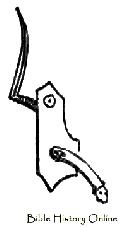
|
Serpentine Without Trigger
|
|
Serpentine without trigger but with spring. |

|
Serpentine With Spring
|
|
Serpentine with spring, but without trigger. |

|
Serpentine Lock
|
|
Serpentine lock, without trigger or spring. |

|
Hackbuss Lock With Spring And Trigger
|
|
Hackbuss lock with spring and trigger. |

|
Hackbuss Or Hand Cannon
|
|
Hackbuss or hand cannon, with butt end and serpentine lock. It belongs to the second half of the 15th century. The match is no longer loose, but fixed to the serpentine which springs back by means of a trigger. |

|
Chinese Arquebuse
|
|
Chinese arquebuse. In the Tower of London. |

|
Swiss Arquebuse
|
|
Swiss arquebuse of the second half of the 15th century. In the Arsenal of Schaffhausen. |

|
Hackbuss Loaded From The Breech By Means Of A Revolving Chamber
|
|
Hackbuss loaded from the breech by means of a revolving chamber. A weapon belonging to the beginning of the 16th century. In the Arsenal of Berne. |

|
Hackbuss And Gun Fork
|
|
Hackbuss and gun fork, from the drawings of Glockenthon. It may also be seen in the engraving of the Triumph of the Emperor Maximilian I. |
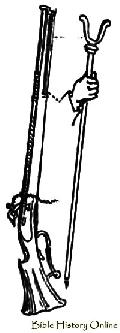
|
Serpentine Hackbuss With Match
|
|
Serpentine hackbuss with match, also called musket. It is also furnished with a fork, called fourquine in French. |

|
Hand Cannon With Rasp
|
|
Hand cannon with rasp, early part of the 16th century. Made entirely of iron and is called monks arquebuse. In the Museum of Dresden. |

|
Hand Cannon On Rest And German Arquebusier
|
|
Hand cannon on rest and German arquebusier. From the designs of Glockenthon, of the three Arsenals of the Emperor Maximilian I. In the Ambras Collection. |

|
Serpentine Hand Cannon And German Soldier
|
|
Serpentine hand cannon and German soldier. From the designs of Glockenthon. |

|
German Soldier With Hackbuss
|
|
German soldier with hackbuss, from the designs of Glockenthon. The hackbuss has a serpentine or dog-head, while the ammunition pouch is seen worn on the right side. |
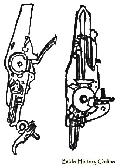
|
Wheel Lock Invented At Nuremberg
|
|
Wheel lock invented at Nuremberg in 1515, with inside view on the right. |

|
Serpentine And Wheel Lock
|
|
Serpentine and wheel lock. |
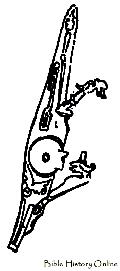
|
Very Elaborate Serpentine And Wheel-Lock
|
|
Very elaborate serpentine and wheel-lock. |

|
Hackbuss Or Musket With Link
|
|
Hackbuss or musket with link. |

|
Wheel-lock Arquebuse Of The 16th Century
|
|
Wheel-lock arquebuse of the 16th century. In the Museum of Artillery in Paris. |
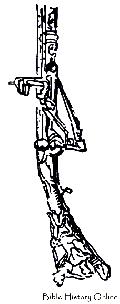
|
Wheel-lock Musket Of The 16th Century
|
|
Wheel-lock musket of the 16th century. In the Museum of Artillery in Paris. |
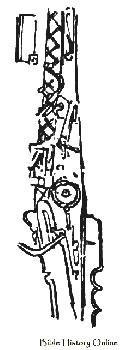
|
16th Century Wheel-Lock Musket
|
|
16th century wheel-lock musket. Loaded from the breech by means of a revolving chamber. In the Museum of Sigmaringen. |

|
Rest Of Wheel-Lock Musket
|
|
Rest of wheel-lock musket, of the beginning of 17th century. About 5 feet 10 inches in length. In the Museum of Sigmaringen. |

|
Rest For Musket
|
|
Rest for musket, of the beginning of the 17th century. In the Collection of Prince Charles at Berlin. |

|
Blunderbuss With Wheel-Lock And Copper Barrel
|
|
Blunderbuss with wheel-lock and copper barrel. Covered over with thick leathern casing, 27 inches n length and the barrel nearly 2 inches in diameter. In the Museum of Sigmaringen. |

|
French Flint Lock And Bayonet Gun
|
|
French flint lock and bayonet gun of the 17th century. |

|
Prussian Flint-Lock And Bayonet Gun
|
|
Prussian flint-lock and bayonet gun. From the time of Frederick the Great. |

|
German Revolver With Turning Cylinder
|
|
German revolver with turning cylinder, firing four-shots. From end of the 18th century. In the Museum of Sigmaringen. |

|
Carbine Revolver
|
|
Carbine revolver, with turning cylinder. Firing eight shots for cavalry use. |

|
Raquette Gun
|
|
Raquette gun of the 18th century. In the Arsenal of Berlin. |
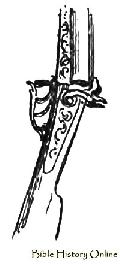
|
Breech-Loading Percussion Gun
|
|
Breech-loading percussion gun, made on the Lefancheux system. |
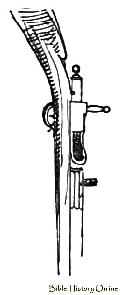
|
Prussian Needle Gun
|
|
Prussian needle gun, invented by a German named Nicolas Dreyse. |
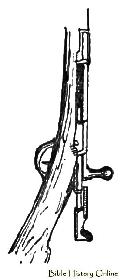
|
French Needle Gun
|
|
French needle gun. Invented by M. Chassepot in 1866 upon the Dreyse model. |











































